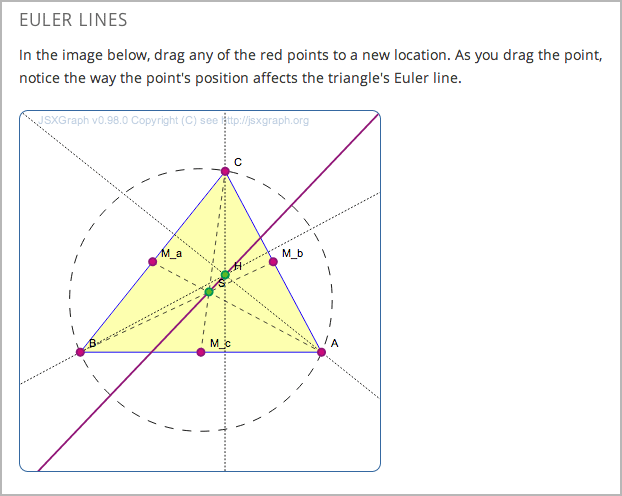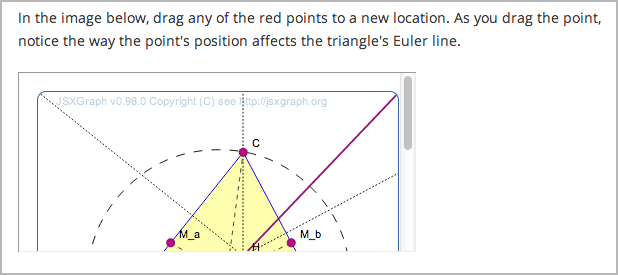11.16. Iframe Tool¶
Note
EdX offers provisional support for this tool.
The iframe tool allows you to integrate ungraded exercises and tools from any Internet site into the body of your course. It places an iframe inside an HTML component, and then the exercise or tool appears inside the iframe. The iframe can include your own tools or third-party tools.

Before you make content or a tool from an external site available through your course, be sure to review the content or tool to ensure that it is accessible to people with disabilities. For example, in addition to testing the iframe components that you add to your course, you can ask third party providers to confirm that a tool is accessible, and, if available, contact your on campus accessibility support services for additional guidance. For more information, see Accessibility Best Practices for Developing Course Content.
Iframes are well-suited for tools that demonstrate a concept, but that are not graded or used to store student data. If you want to add a graded tool or exercise, add the tool as a custom JavaScript problem or an LTI component.
For more information about iframes, see the HTML/Elements/iframe specification.
11.16.1. Create an IFrame Tool¶
To add an exercise or tool in an iframe, you create an iframe HTML component and add the URL of the page that contains the exercise or tool to the component. You can also add text and images both before and after the iframe.
Note
The URL of the page that contains the exercise or tool must start
with https instead of http. If the URL starts with http, work with
the owner of that page to find out if an https version is available. Some
websites do not allow their content to be embedded in iframes.
Under Add New Component, select HTML, and then select IFrame Tool.
In the new component, select Edit.
In the visual editor toolbar, select HTML.
In the HTML source code editor, locate the following HTML (line 7). This HTML includes the
<iframe>element.<p><iframe src="https://studio.edx.org/c4x/edX/DemoX/asset/eulerLineDemo.html" width="402" height="402" marginwidth="0" marginheight="0" frameborder="0" scrolling="no">You need an iFrame capable browser to view this.</iframe></p>
Replace the default URL in the
srcattribute (https://studio.edx.org/c4x/edX/DemoX/asset/eulerLineDemo.html) with the URL of the page that contains the exercise or tool. This URL must start with https. Make sure that you do not delete the quotation marks that surround the URL.Change the attributes in the iframe element to specify any other settings that you want. For more information about these settings, see Iframe Settings. You can also change the text between the opening and closing
<iframe>tags. Learners see this text only when they use a browser that does not support iframes.Select OK to close the HTML source code editor and return to the visual editor.
In the visual editor, replace the default text with your own text.
Select Save.
11.16.1.1. Iframe Settings¶
To specify settings for your iframe, you add, remove, or change the
attributes inside the opening <iframe> tag. The <iframe> tag must
contain a src attribute and a title attribute. Other attributes are
optional.
You can add these attributes in any order you want.
| Attribute | Description |
|---|---|
src (required) |
Specifies the URL of the page that contains the exercise or tool, beginning with https. |
title (required) |
Describes the content or its purpose in the context of the course. |
width and height (optional) |
Specify the width and height of the iframe, in pixels or as a percentage. To specify the value in pixels, enter numerals. To specify a percentage, enter numerals followed by a percent sign. If you do not specify the width and height, the iframe uses the dimensions that the linked page has set. These dimensions vary by website. If you change the width and height of the iframe, the content from the linked page might be resized, or only part of the content may appear. |
marginwidth and marginheight (optional) |
Specify the size of the space between the edges of the iframe and your exercise or tool, in pixels. |
frameborder (optional) |
Specifies whether a border appears around your iframe. If the value is 0, no border appears. If the value is any positive number, a border appears. |
scrolling (optional) |
For an iframe that is smaller than the exercise or tool it contains, specifies whether a scrollbar appears to help users access all of the iframe’s content. For example, if the content in your iframe is very tall, you can set the iframe’s height to a smaller number and add a vertical scroll bar for users, as in the first image below. |
For example, compare how the different settings in each of the <iframe>
elements below affect the iframe.
<p><iframe src="https://studio.edx.org/c4x/edX/DemoX/asset/eulerLineDemo.html" width="442" height="200" marginwidth="20" marginheight="20" frameborder="1" scrolling="yes">You need an iFrame capable browser to view this.</iframe></p>

<p><iframe src="https://studio.edx.org/c4x/edX/DemoX/asset/eulerLineDemo.html" width="550" height="250" marginwidth="30" marginheight="60" frameborder="1" scrolling="no">You need an iFrame capable browser to view this.</iframe></p>

For more information about iframe attributes, see the HTML/Elements/iframe specification.